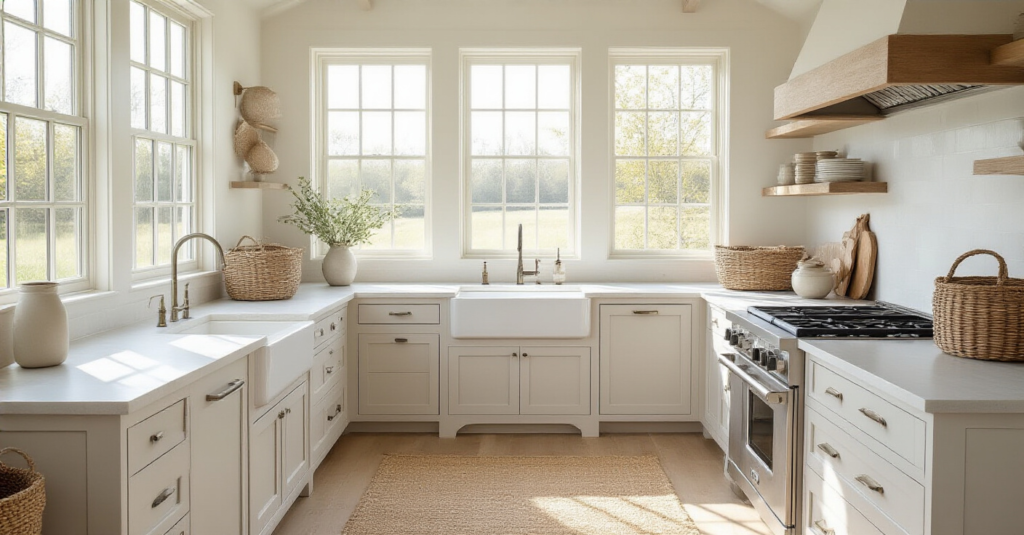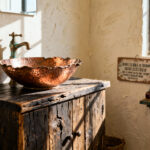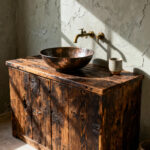Picture this: You’re standing on your patio, drink in hand, listening to the birds settle in for the evening. The big sliding doors to your kitchen are open, and a warm glow spills out, smelling faintly of roasted chicken and fresh-cut herbs from your garden.
That connection—that seamless flow between the life you live inside and the natural world just beyond your walls—is what we’re all chasing. And you know what people always ask me about creating that feeling? They ask about the kitchen. Not just any kitchen, but one with soul. A farmhouse kitchen.
The problem is, “farmhouse” has become a marketing buzzword for anything painted white with a faux-distressed sign. But a true farmhouse kitchen isn’t a theme you buy at a big-box store. It’s an approach. It’s about durability, honesty in materials, and creating a functional hub that feels like it’s been the heart of the home for generations, even if you just finished it last week.
So, let’s cut through the noise. Here’s what actually matters when you’re trying to create that warm, authentic, and truly timeless kitchen.
Laying the Foundation & Core Elements
This is the stuff you absolutely have to get right. Think of it as the bedrock. You can’t build a beautiful, lasting garden on poor soil, and you can’t build a great farmhouse kitchen without a solid foundation. These aren’t the sexy details, but they’re the choices that will make or break the entire space.
1. Define a Timeless White or Neutral Color Palette for Brightness
Look, everyone will tell you to paint your farmhouse kitchen white. But what they don’t tell you is that there are a million whites, and picking the wrong one can make your kitchen feel like a hospital cafeteria. The goal isn’t just to make it bright; it’s to make it feel like it’s lit by the sun, even on a cloudy day. A good neutral palette is like a clear sky—it’s the perfect, unobtrusive backdrop for everything else.

The secret is undertones. A white with a yellow or pink undertone feels warm and inviting, perfect for a north-facing room that needs some help. A white with a slight blue or gray undertone feels crisp and clean, great for balancing out intense southern light. Forget the stats about what color sells best; find the one that makes your specific room feel good. Always, always paint big swatches on different walls and watch how they change with the light throughout the day before you commit.
Once you have your core color, you’ll be setting the stage for the big players, starting with your cabinetry.
2. Choose Shaker-Style Cabinets for Classic Farmhouse Appeal
I used to have clients who wanted the most ornate, detailed cabinets they could find. A few years later, those kitchens looked incredibly dated. Can we all just agree to stop getting this wrong? The beauty of farmhouse design is its timeless simplicity, and nothing embodies that better than a Shaker-style cabinet. Its clean lines and lack of fuss are the blue jeans of the kitchen world—they just work, forever.
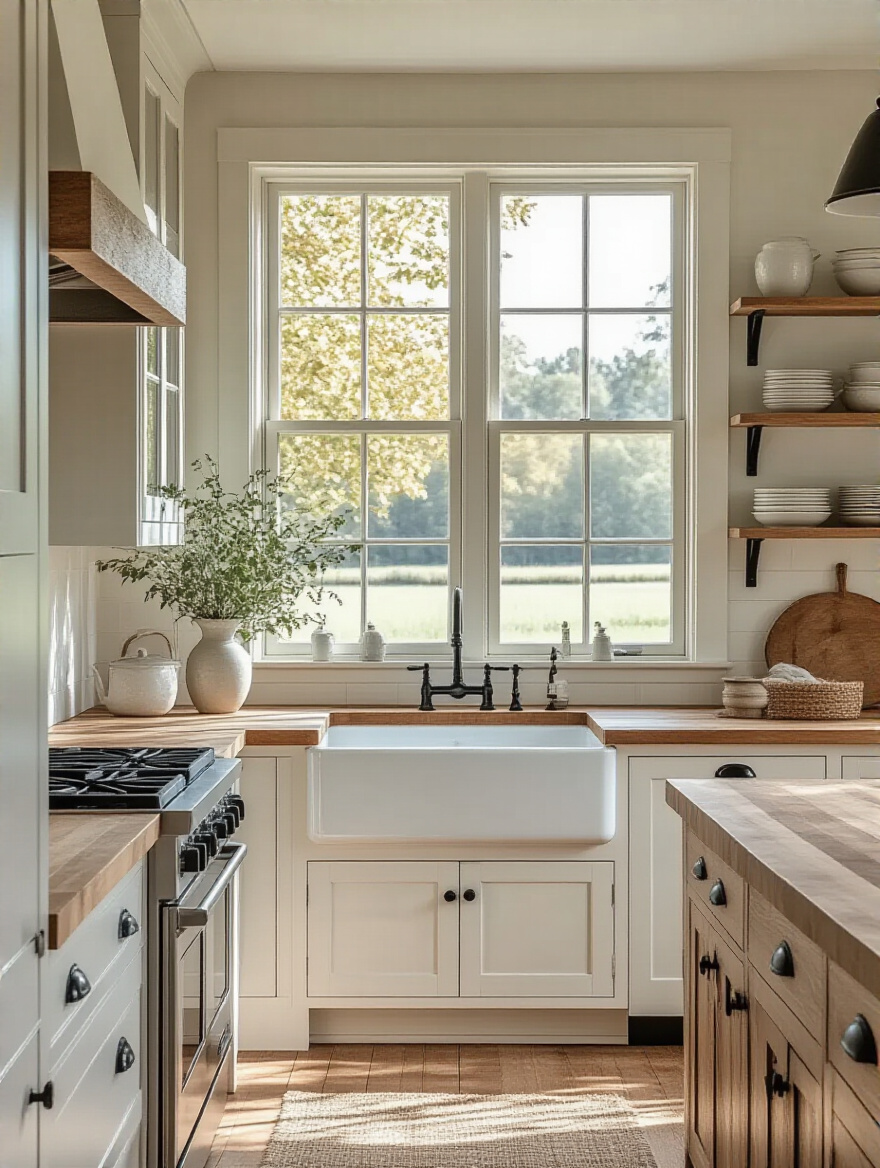
The genius of Shaker design is that it was born from a principle of utility. No extra ornamentation, just solid construction and pure function. This is why it has lasted for centuries while other trends have come and gone. It provides a quiet, rhythmic backdrop that lets other elements—like a beautiful slab of wood or some vintage hardware—do the talking. It’s a choice you simply will not regret.
With that quiet, sturdy foundation in place, it’s time to choose what’s underfoot.
3. Select Durable Hardwood or Wide-Plank Flooring for Warmth
There is nothing—and I mean nothing—that can replicate the feeling of a real wood floor. It’s the difference between walking on solid ground and walking on plastic. Hardwood, especially wide-plank, immediately connects a home to the natural world. You can feel the grain, see the history in the knots, and it grounds the entire space with an irreplaceable warmth.
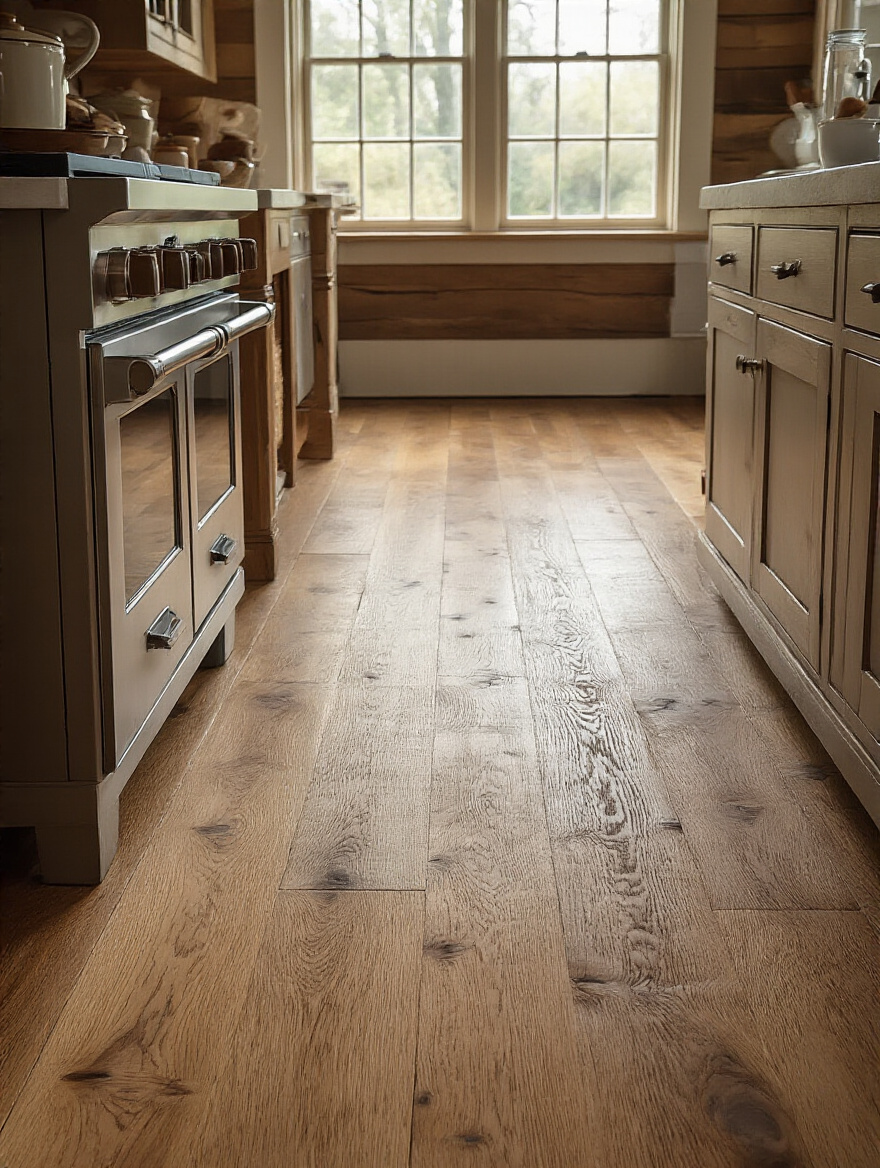
Now, everyone panics about wood in a kitchen because of water. I get it. The shortcut here is to go with a high-quality engineered hardwood. It has a real wood top layer, so you get all the visual beauty and warmth, but its core is designed for more stability in humid environments. But no matter what you choose, the character of real wood is the point. Don’t be afraid of a few dings or scratches over the years. That’s not damage; that’s the story of your life being written into the floor of your home.
Now that the floors are down, let’s talk about the single most iconic piece in the whole room.
4. Install a Deep Apron-Front Sink for Iconic Utility
People see an apron-front sink and just think, “farmhouse.” And they’re right. But it’s so much more than just a style cue. This thing is a workhorse. It was originally designed for farm life—washing vegetables from the garden, filling big pails, bathing babies. Its beauty comes directly from its unbeatable function. You can fit giant stockpots and cookie sheets in there without a fight.
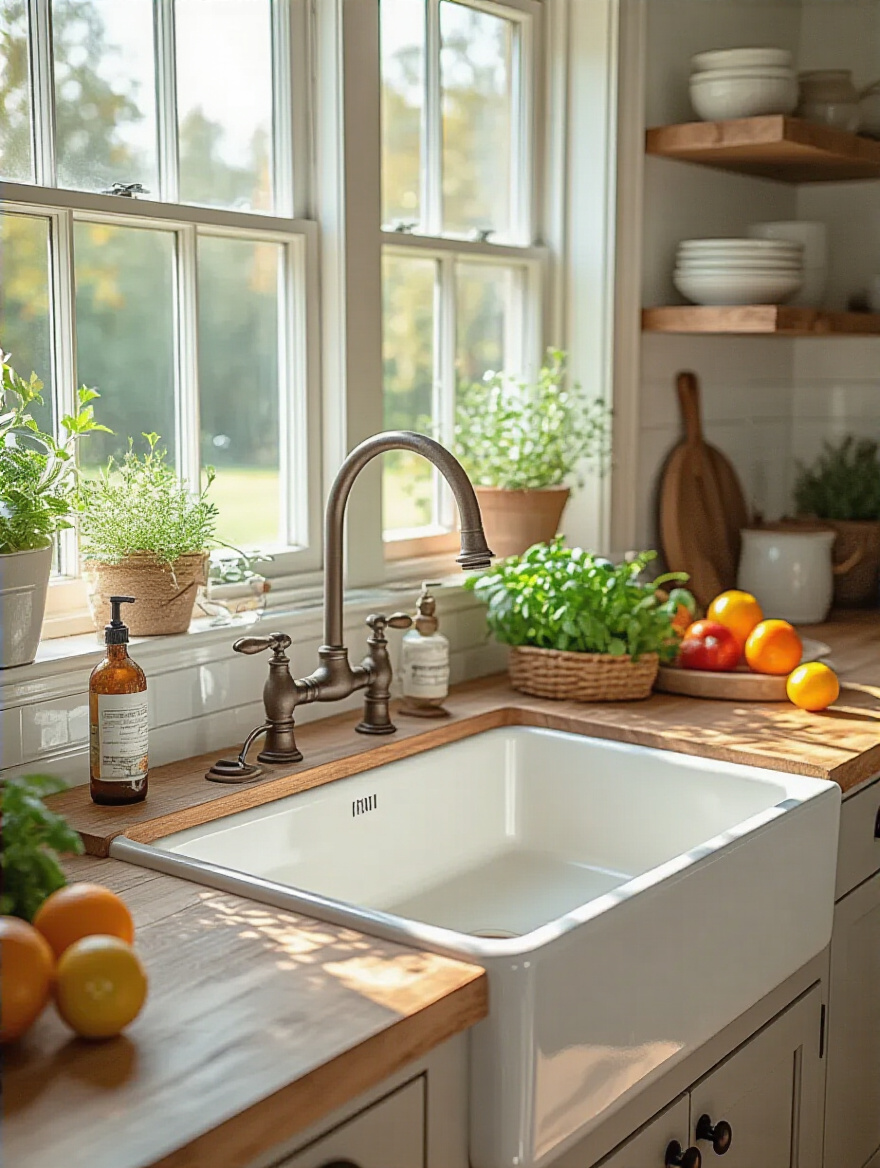
I confess, I used to think it was just an aesthetic choice. Then I helped a friend install one, and a few months later he told me it had completely changed how he used his kitchen. He could finally wash the giant grates from his grill inside. The one thing people always get wrong is the installation. You can’t just drop this into a standard cabinet. It’s heavy, especially fireclay models, and needs a dedicated, properly supported base cabinet. Plan for it from the beginning, because retrofitting it is a massive, expensive headache.
With that powerhouse sink anchoring one wall, let’s make sure the whole room flows properly.
5. Optimize Your Kitchen Layout for Functional Farmhouse Flow
The best farmhouse kitchens feel effortless. You can move from the fridge to the sink to the stove without running a marathon, and multiple people can work without constantly bumping into each other. It’s less about a rigid “work triangle” and more about creating intuitive zones for how you actually live. Where do the groceries land? Where do you chop? Where do the dirty dishes go?
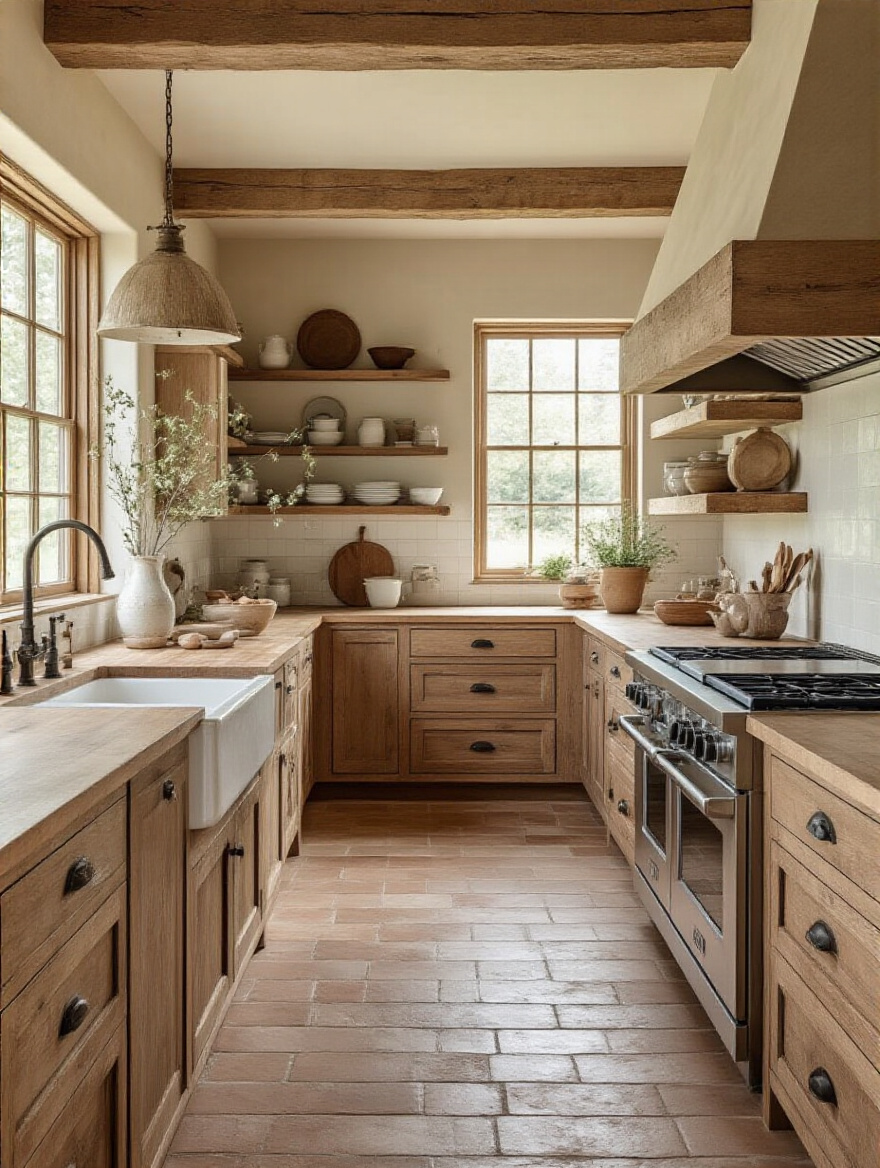
Before you even think about cabinets, grab some painter’s tape and map out the new layout on your floor. Mark where the island, fridge, and stove will go. Then, walk it. Pretend you’re making dinner. Pretend you’re unloading the dishwasher. Open the imaginary doors. Is there enough room? I’ve watched a client save thousands by doing this, realizing the island they planned was going to create a frustrating bottleneck right by the fridge. A functional layout is invisible when it’s right, and a constant, low-grade annoyance when it’s wrong.
Incorporating Essential Farmhouse Style Details
With the bones of your kitchen set, it’s time for the fun part. These are the material choices that bring the character. They’re the textures and finishes that take a kitchen from simply “new” to feeling soulful and established.
6. Integrate Natural Wood Elements for Rustic Character
This is where you can truly start to blur the lines between inside and out. Beyond the floor, bringing in other natural wood elements is what gives a farmhouse kitchen its soul. Think thick, rustic open shelves, an exposed ceiling beam, or a big, chunky top for your island. These pieces add a layer of organic texture and history that painted surfaces alone just can’t touch.
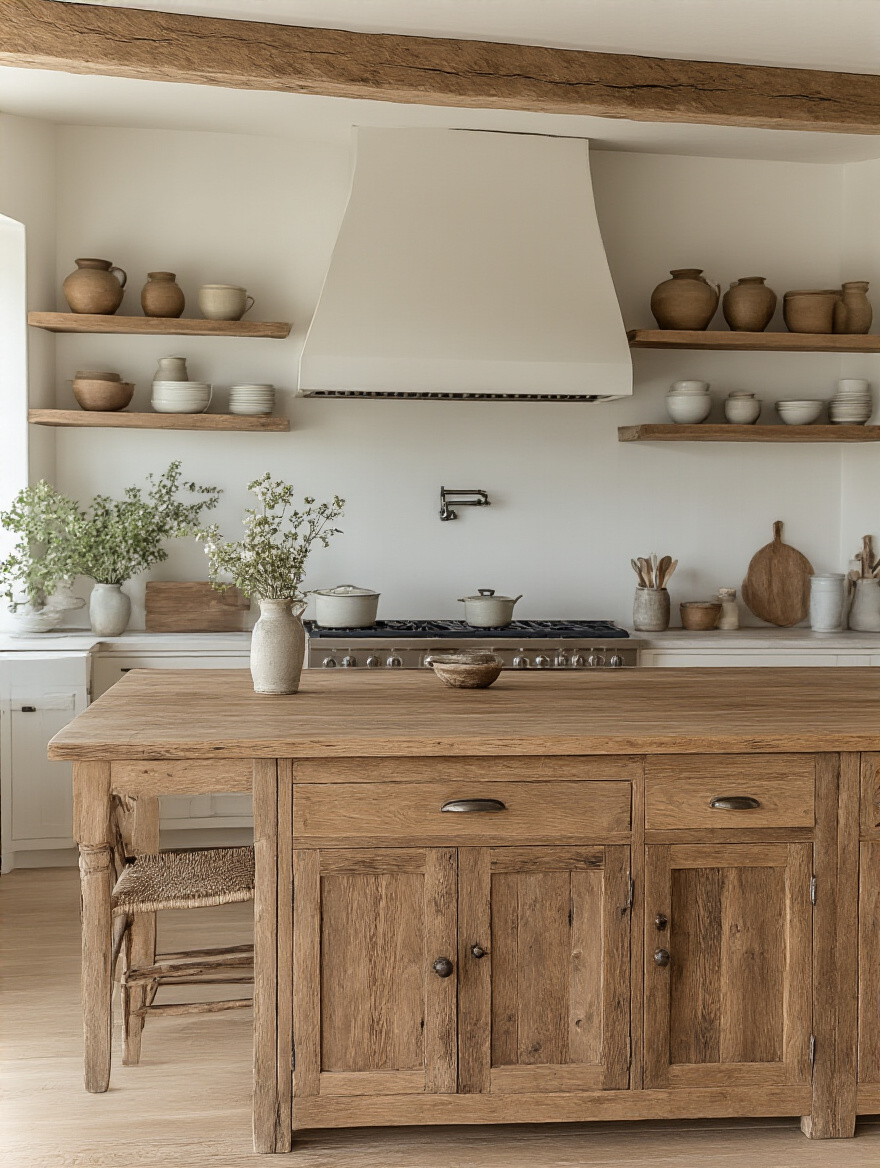
I once worked on a project where the kitchen was perfectly nice—all white Shaker cabinets and clean lines—but it felt sterile. We added a single, thick, reclaimed wood beam across the ceiling and suddenly, the whole room came to life. It gave the space an anchor and a sense of history. The key is to not go overboard. A few strategic, impactful pieces are far more effective than trying to make everything wood, which can end up looking like a dated 70s cabin.
The warmth of the wood provides the perfect foundation for a bit of contrasting industrial edge overhead.
7. Hang Industrial-Inspired Pendant Lighting Over Your Island
A farmhouse kitchen shouldn’t be all soft and rustic. It needs a little tension to keep it interesting, and that’s where industrial lighting comes in. A few metal pendants with exposed bulbs or a simple, functional shape hanging over an island provides a beautiful contrast to all the natural wood and soft colors. It’s a nod to the utilitarian, workshop side of farm life.
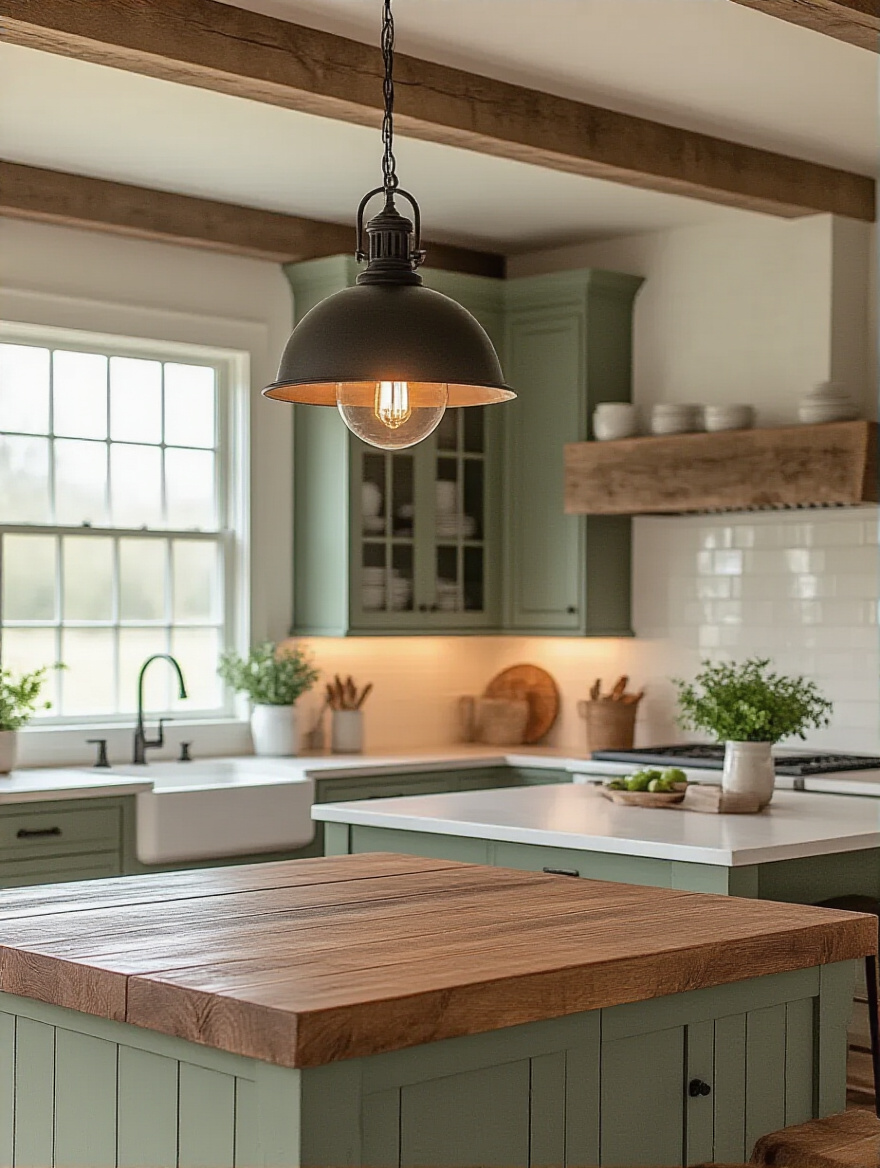
Think of it as adding a dash of salt to a sweet dish—it brings out all the other flavors. Functionally, it also provides excellent task lighting right where you need it most. Just be sure to get the scale right. Tiny pendants over a huge island look silly. And the ultimate pro tip? Put them on a dimmer. Always. This lets you go from bright, functional light for chopping to a low, warm glow for a late-night chat over a glass of wine.
From the lighting above to the hardware you touch every day, the details matter.
8. Choose Unlacquered Brass or Cast Iron Hardware for Authenticity
Here’s my pet peeve: perfectly sealed, shiny hardware that looks the same on day one as it does on day one thousand. A true farmhouse feels lived-in, and the materials should reflect that. This is why unlacquered brass or simple cast iron is such a game-changer. These are “living finishes,” meaning they react to the oils in your hands and the air around them, developing a rich, beautiful patina over time.
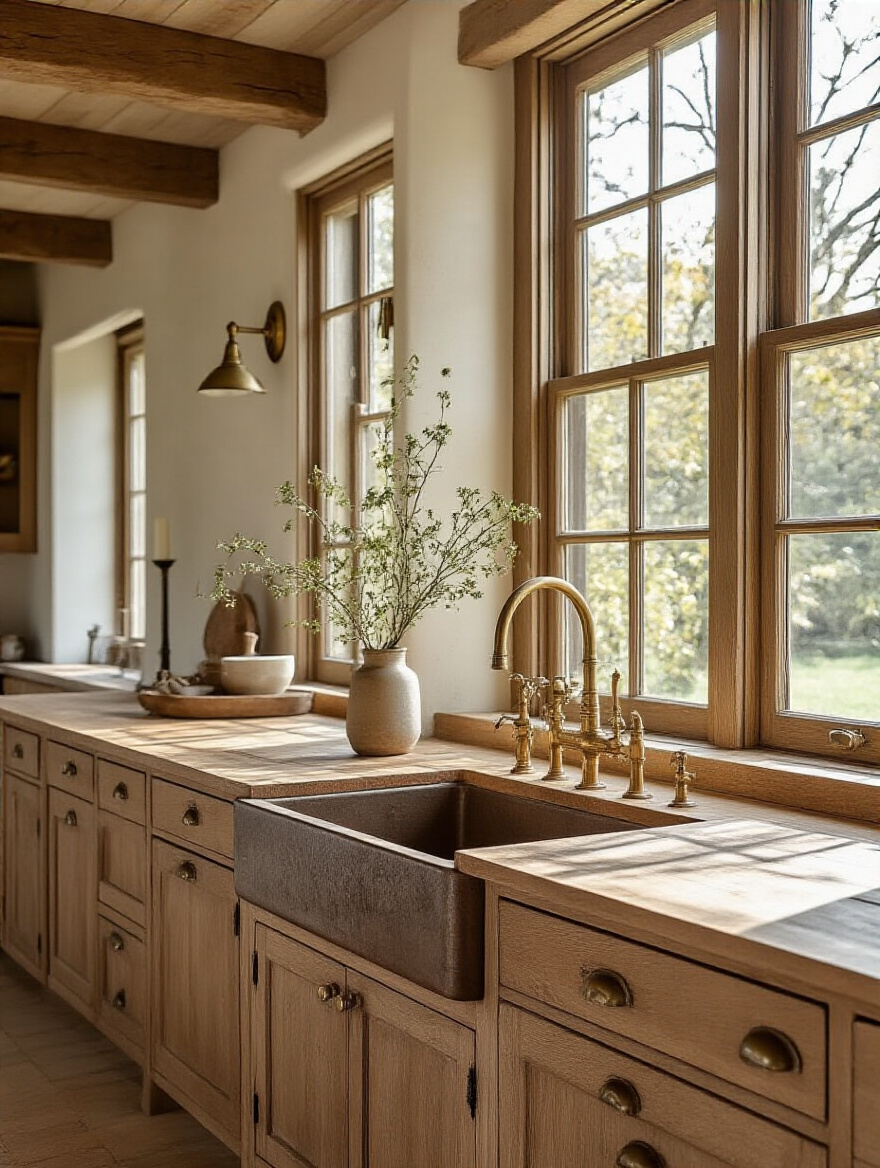
This isn’t a flaw; it’s the entire point. An unlacquered brass knob will darken and age differently depending on how often it’s touched, telling a subtle story of how the kitchen is used. It’s the same way a stone path weathers over the years. It shows life. It might take a little extra effort to source, but that single choice will give your kitchen more authentic character than almost anything else.
That tactile, aging quality should extend to your countertops, too.
9. Select Butcher Block or Quartz Countertops for Durability and Charm
This decision really comes down to how you live. For pure, unadulterated warmth and charm, nothing beats a thick wood butcher block countertop. It’s soft, it’s forgiving on dishes, and it develops a beautiful patina from years of chopping and use. It feels like a true piece of working furniture, a direct connection to the “farm to table” ethos. It does require some maintenance—oiling it every now and then—but the payoff in soulfulness is huge.
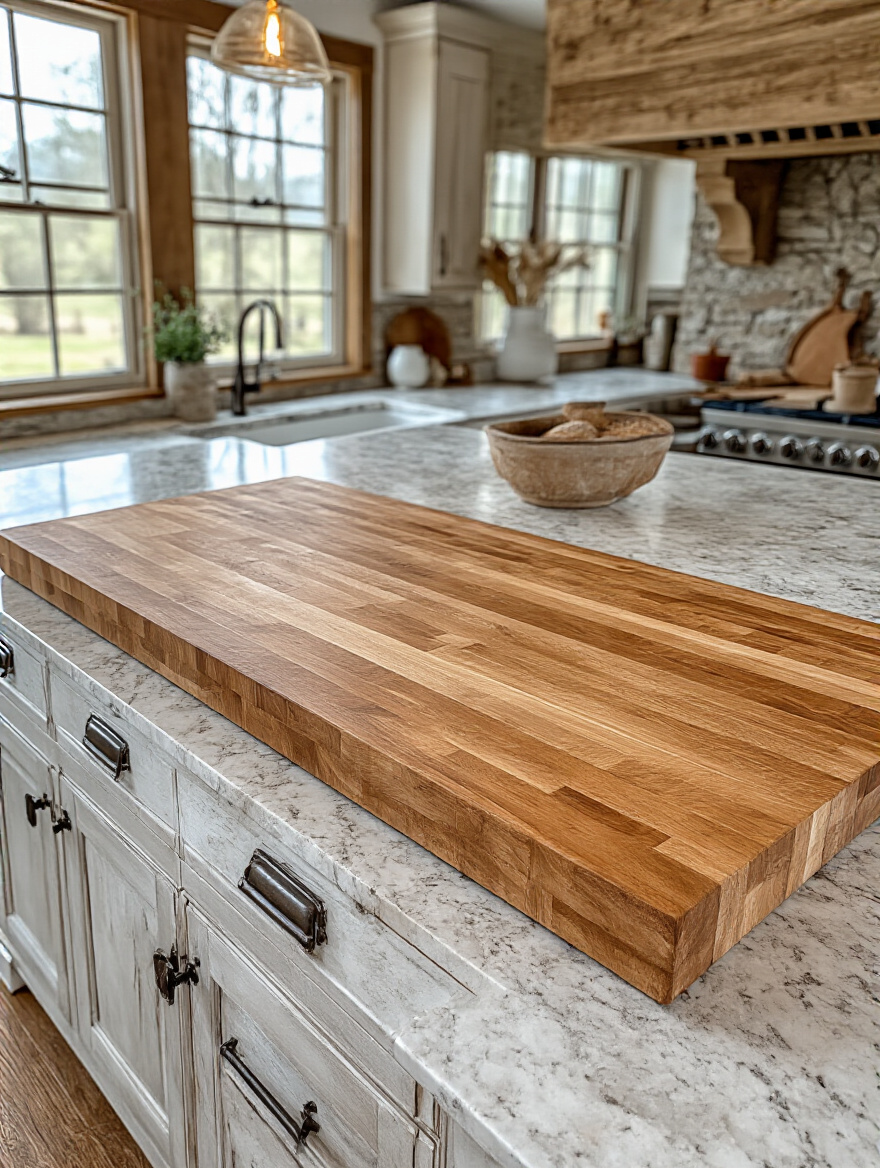
On the other hand, if you have a busy family and the thought of oiling a countertop makes you break out in a cold sweat, quartz is your best friend. It’s virtually indestructible, stain-proof, and you can find it in beautiful, subtle patterns that mimic natural stone or in a simple, clean white. A great compromise I see a lot is to do a butcher block on the island, where you want that warmth and character, and use a durable quartz for the hard-working perimeter counters around the sink and stove. It’s the best of both worlds.
And at the center of it all, that island deserves to be a grand statement.
10. Design a Large Central Island for Family Gatherings
If the apron-front sink is the soul of a farmhouse kitchen, the large central island is its heart. This is where life happens. It’s not just a prep space; it’s a homework station, a buffet for parties, a place for friends to lean and chat while you cook. It’s a gravitational center that pulls everyone in. The bigger, the better, as long as you maintain enough clearance to move around it comfortably (aim for at least 42 inches).
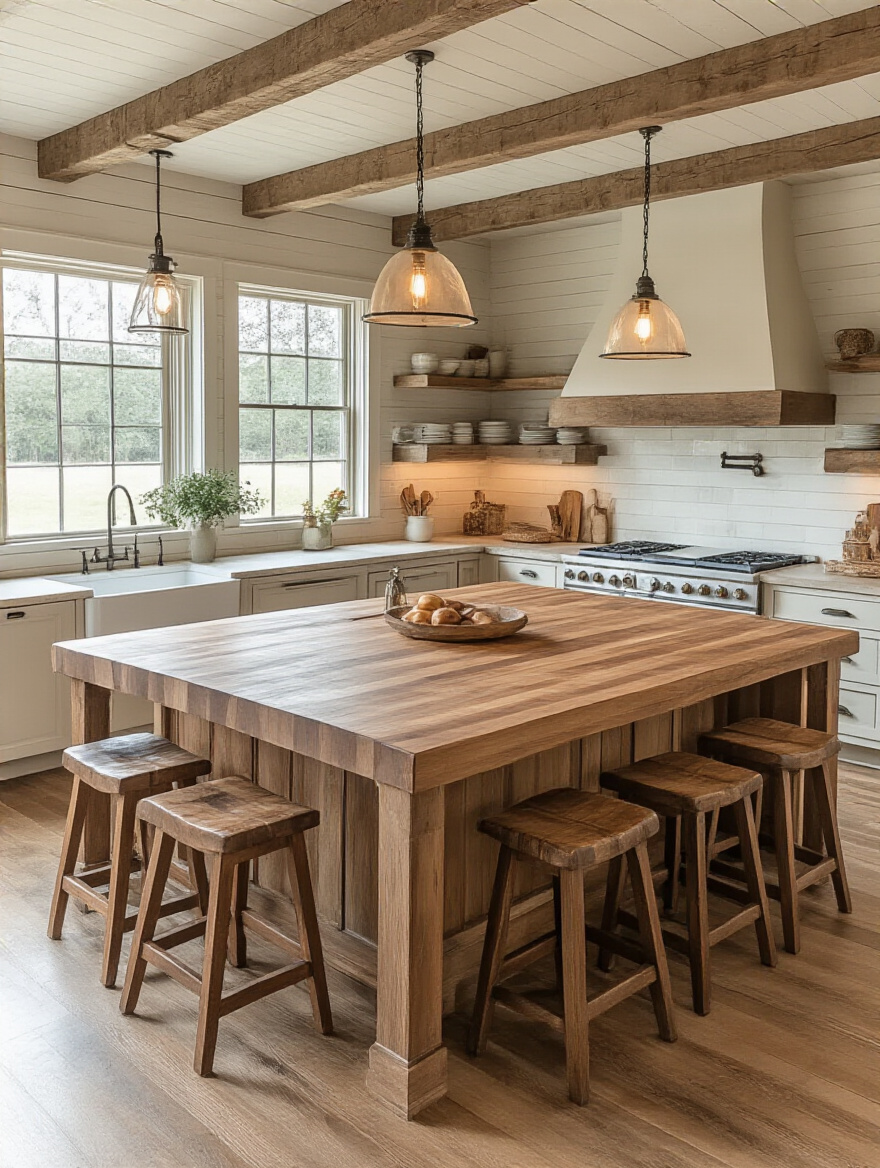
The mistake I see people make is designing an island that’s just a big block. A great island has zones. Maybe one end is for prep, with a small sink. The other end has an overhang for seating. You should plan for power outlets, maybe even with USB ports, because you know that’s where everyone will want to plug in their devices. Making it a different color or material from your main cabinets is also a great way to make it feel more like a unique piece of furniture.
Beyond the island, a dedicated dining spot solidifies the kitchen as the home’s primary gathering place.
11. Add a Distressed Wood Farmhouse Table for Dining Warmth
Even if you have a formal dining room, having a sturdy, well-loved table right in the kitchen is essential for that cozy, communal farmhouse feeling. And a distressed wood table is key. We’re not talking about something that looks like it was attacked with a chain in a factory. We’re talking about a table made from solid, character-grade or reclaimed wood that’s not afraid of a little wear and tear.

A pristine, polished table makes people nervous. A distressed farmhouse table invites you to put your elbows on it, to let the kids do their art projects there. Every new scratch or water ring just adds to its story. For a truly authentic look, forget the matching chair set. Mix it up. Pair the table with a couple of Windsor chairs, a long bench on one side, and maybe even a few metal bistro chairs. It will look like it was collected over time, which is the entire goal.
Adding Warmth & Authenticity with Decor
Now that the major pieces are in place, we get to layer in the personality. This is where you tell your story. Decor in a farmhouse kitchen shouldn’t feel like “decor”—it should feel like a natural extension of a life well-lived.
12. Showcase Collected Dinnerware on Open Shelving Displays
The obsession with hiding everything behind solid doors is a modern affliction. A true farmhouse kitchen is a working room, and the tools should be at hand. Open shelving is the perfect way to achieve this. It forces you to be honest about what you own, and it turns your everyday dishes into a beautiful, functional display. A stack of simple white plates, some mismatched vintage bowls—it’s honest, and it’s beautiful.

The key to preventing it from looking messy is curation. You don’t have to display everything. Pick your most-used and most-loved pieces. Group similar items together. I saw a client do this beautifully—they had three long, rustic wood shelves. The bottom held their everyday white plates and bowls. The middle held glassware. And the top, harder to reach, held a few beautiful old pitchers they’d collected. It was practical, personal, and stunning.
Those personal touches can extend to the walls, too.
13. Introduce Vintage Signs or Artwork for Characterful Wall Decor
Your walls are a canvas. Leaving them blank is a missed opportunity to add a layer of history and personality. This is where you can have a lot of fun at flea markets or antique shops. A simple, authentic vintage sign—for a dairy, a general store, or a local farm—can instantly add a sense of place and time that you just can’t buy new.
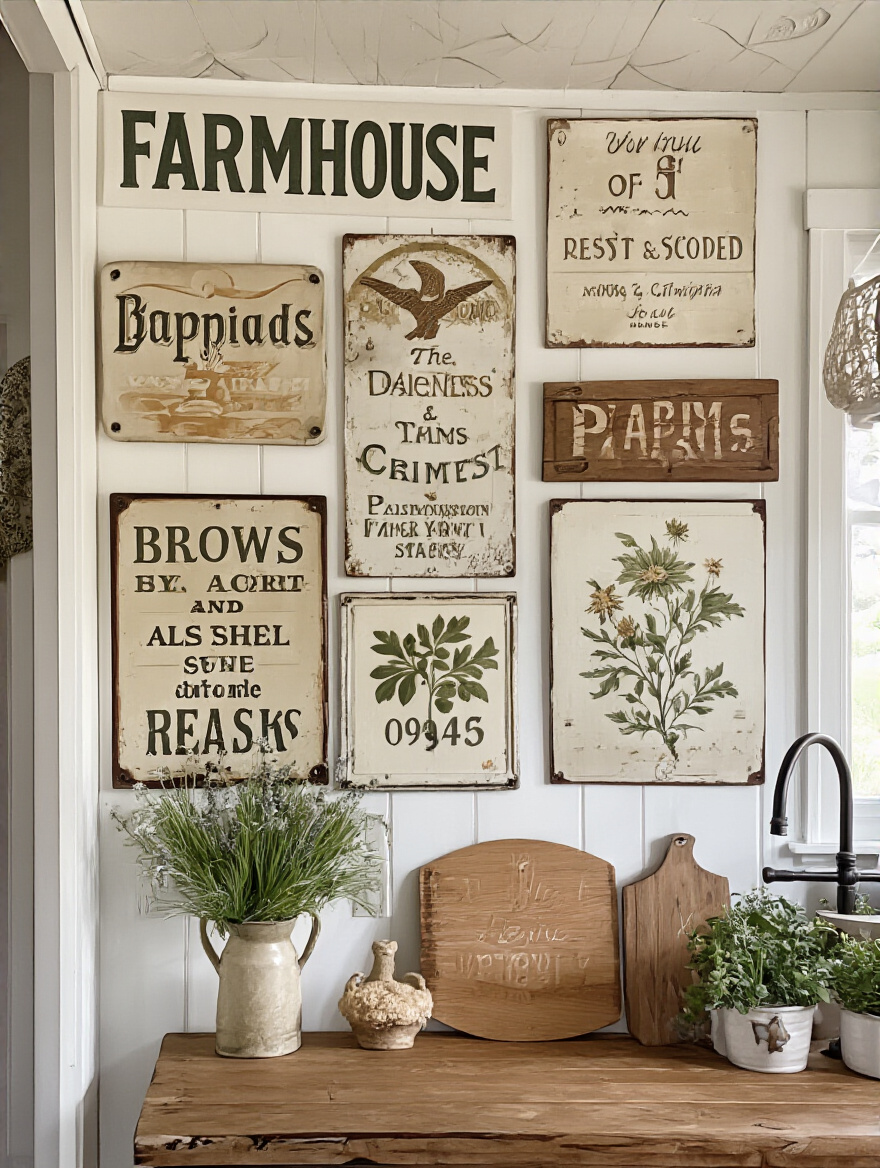
But it doesn’t have to be a sign. A collection of small, framed botanical prints of herbs, or even a moody oil painting of a rural landscape can add incredible depth. The goal is to find pieces that tell a story or connect to the idea of food, farming, or nature. Avoid the mass-produced stuff that says “EAT” in big letters. Look for something with genuine age and soul. It’s what makes the space uniquely yours.
From visual warmth on the walls, we move to the tactile softness you can feel.
14. Layer Natural Textiles Like Linen and Cotton for Softness
A kitchen is full of hard surfaces—stone, wood, metal, tile. It’s essential to soften those edges with natural textiles. A simple linen tea towel slung over the sink, cotton napkins in a basket, or a soft Roman shade on the window can completely change the feel of the room. It’s like adding pillows to a sofa—it signals comfort.
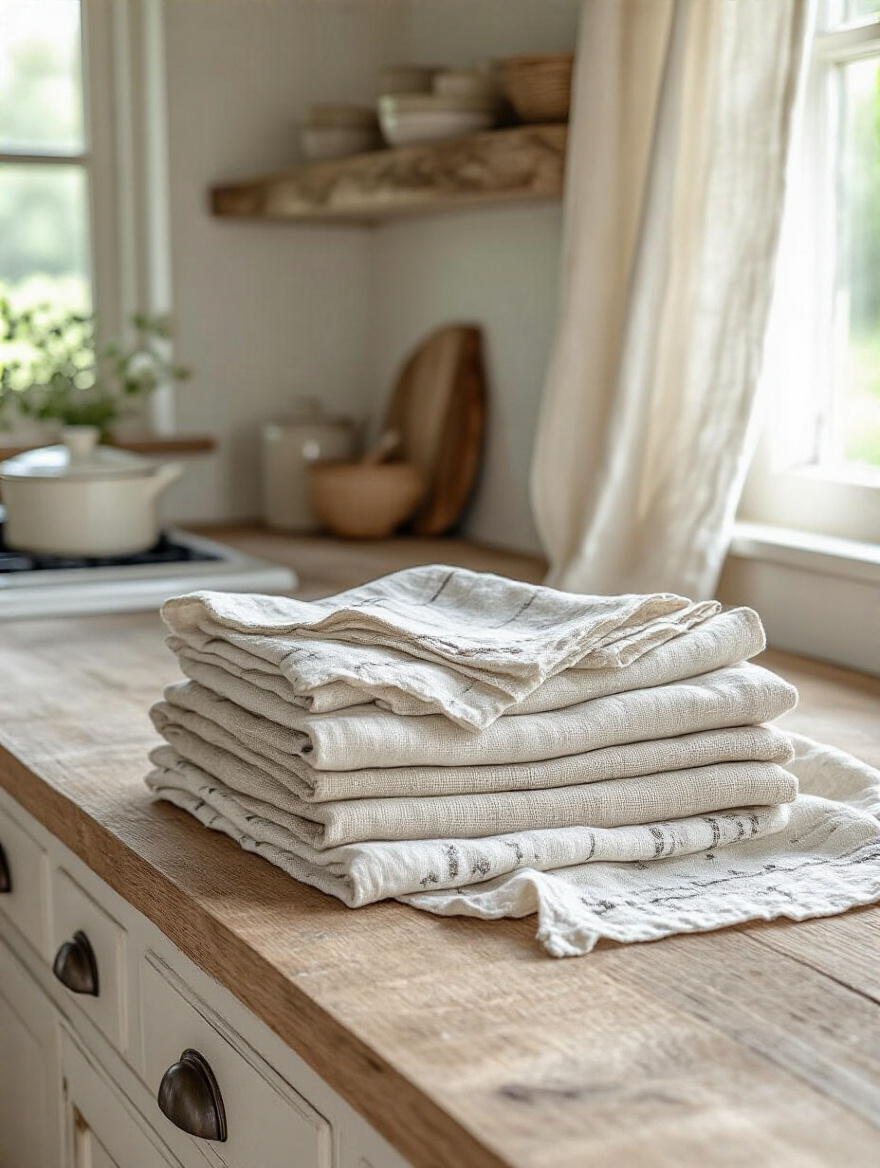
What everyone gets wrong here is aiming for perfection. The beauty of natural fibers like linen is their imperfection. Don’t iron your linen tea towels into crisp submission! Let them be a little rumpled. It’s part of the relaxed, casual charm. These small textile additions absorb sound, add texture, and make the whole kitchen feel more human and inviting.
This principle of beautiful utility extends to the items you use every day.
15. Display Practical Items as Decorative, Functional Pieces
The heart of farmhouse philosophy is that useful things should also be beautiful. Don’t hide all your tools away. A well-worn stack of wooden cutting boards leaning against the backsplash, a crock full of wooden spoons by the stove, a beautiful copper pot hanging from a rack—these aren’t clutter. They are signals that this is a real, working kitchen where good food is made.
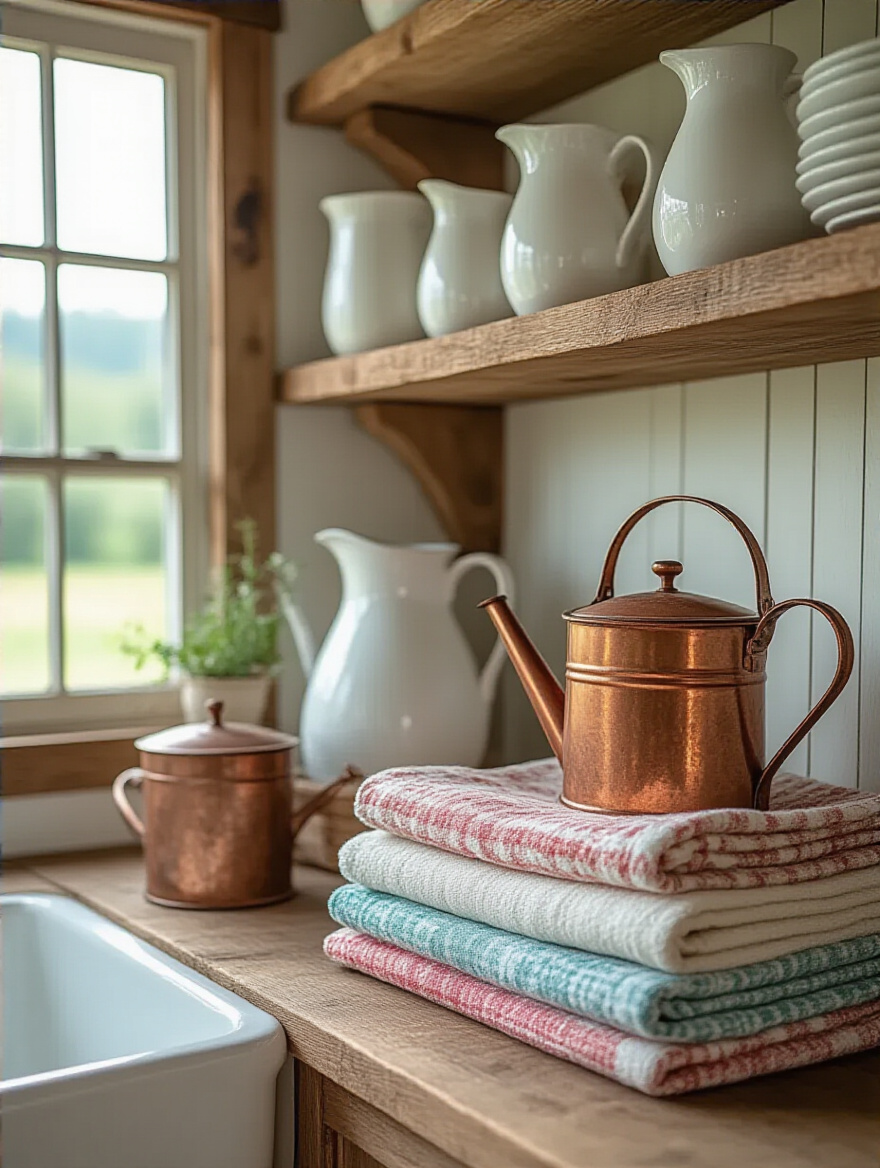
This approach not only adds immense character but is also incredibly practical. Your most-used items are right where you need them. The key is to be intentional. Choose a cohesive palette of materials—wood, copper, cast iron, white ceramic—so that even a variety of items feels harmonious. It’s a curated display of your best-loved, hardest-working tools.
To really bring the space to life, you need, well, actual life.
16. Incorporate Fresh Greenery and Herbs for Natural Vibrancy
No room, especially a kitchen that aims to connect with nature, is complete without plants. It is the fastest, cheapest, and most effective way to breathe life and energy into a space. A small pot of herbs on the windowsill isn’t just decorative; it’s your future garnishes and seasonings, right at your fingertips. A trailing pothos cascading from the top of a cabinet softens the hard lines of the cabinetry.
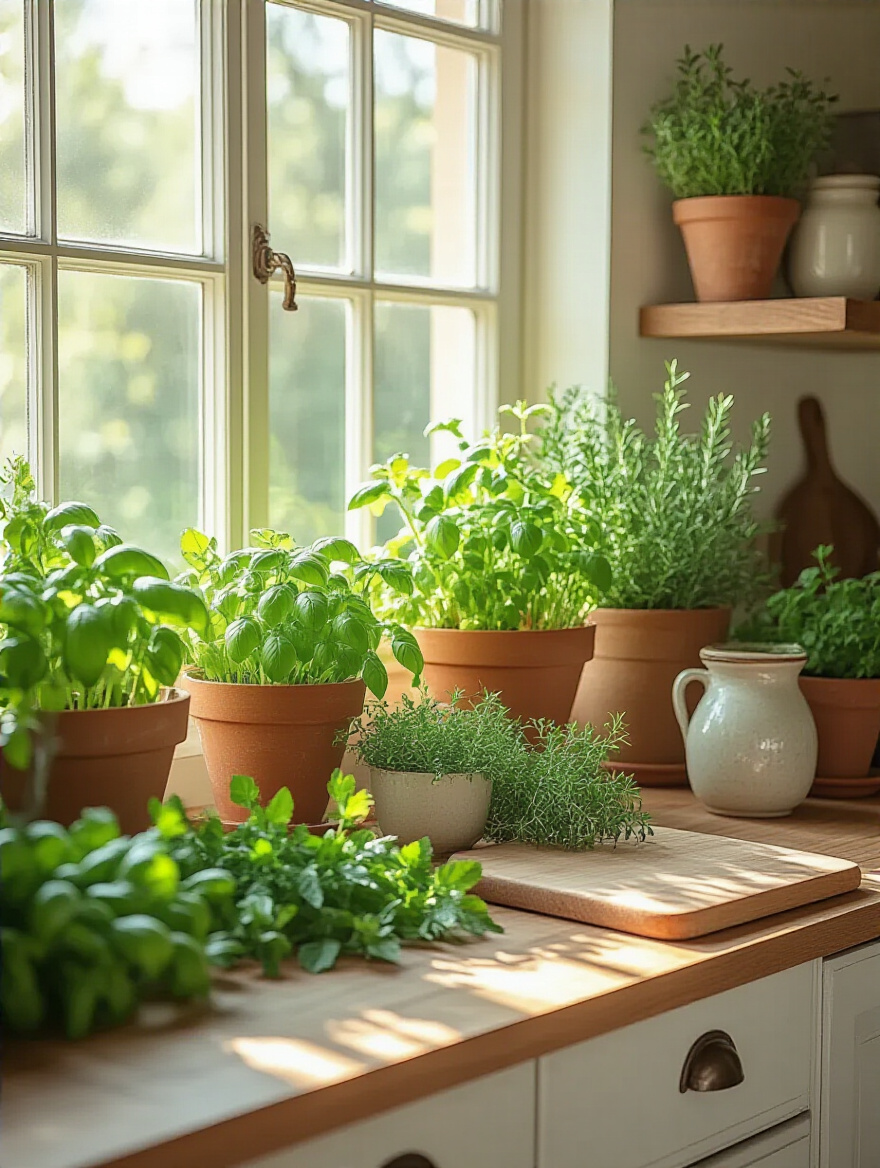
You don’t need to turn your kitchen into a jungle. A few well-placed plants are all it takes. Think about pots that fit the aesthetic—simple terracotta, galvanized metal, or vintage ceramic crocks. This is the most literal way to bring the outside in, and it makes an enormous difference in how vibrant and healthy the room feels.
For organization that fits the aesthetic, look to another natural material.
17. Utilize Wicker Baskets for Organized, Charming Storage Solutions
Wicker and woven baskets are a farmhouse kitchen’s secret weapon for storage. They are the perfect solution for wrangling all the little things that create clutter. Use a few on an open shelf in the pantry to hold bags of snacks or pasta. Keep one on the counter for incoming mail. Slide a couple of larger ones under a console table for kids’ art supplies.
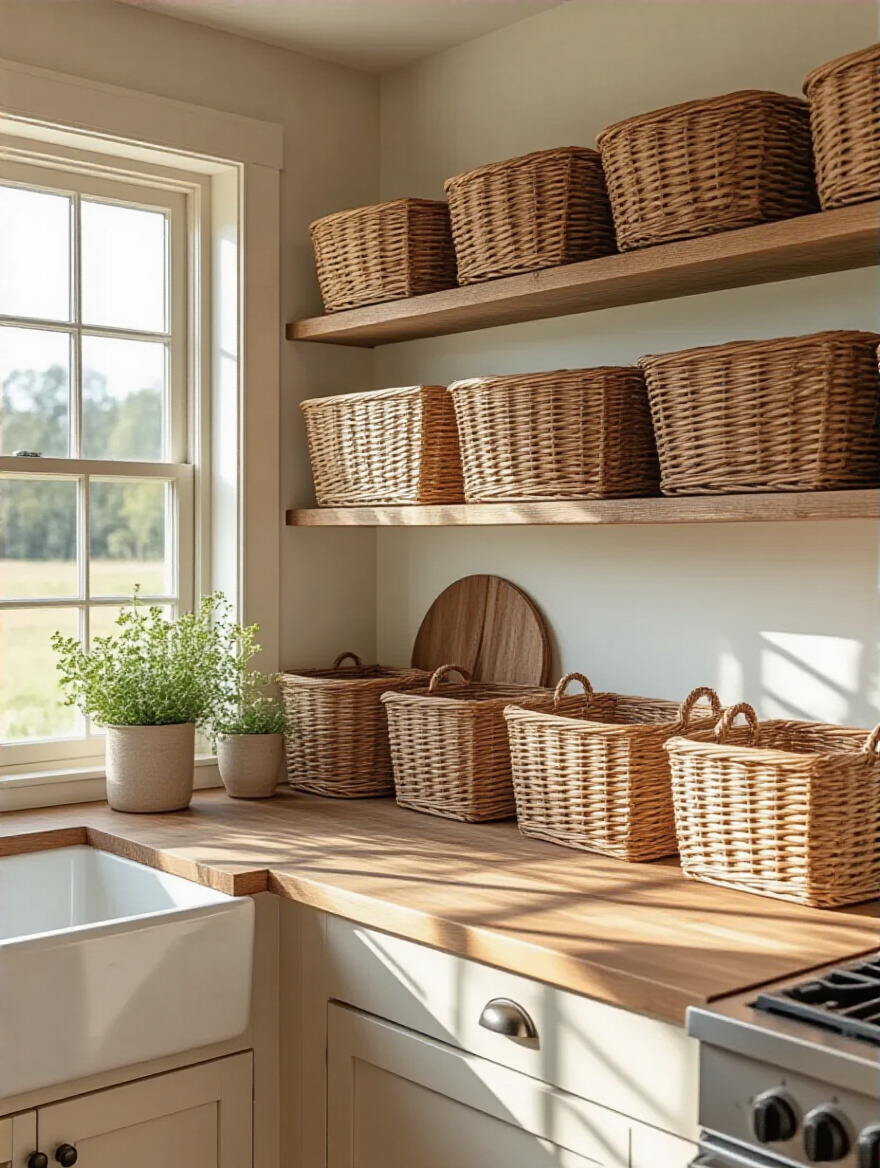
The natural texture of the woven material instantly adds a layer of rustic warmth and softness. It’s so much more appealing than clear plastic bins. I had a client who had a beautiful open-shelf pantry, but it always looked messy. We got a dozen uniform wicker baskets, slapped a simple label on each one, and suddenly it looked like a page out of a magazine. It’s organized charm at its best.
Creating Functional & Welcoming Spaces
Finally, let’s talk about a few bigger, structural elements that elevate a farmhouse kitchen from great to truly exceptional. These are the built-in features that create those cozy, functional nooks that make a house a home.
18. Build a Dedicated Pantry with Sliding Barn Doors
Let’s be honest: a sliding barn door is a bit of a farmhouse cliché at this point. But there is one place where it is undeniably perfect, and that is on a pantry. It’s a brilliant space-saver, since you don’t need to account for door swing, and it provides a massive dose of rustic character. It turns a purely functional storage space into a major design statement.

Behind that door, a dedicated, walk-in pantry is a true luxury. It gets all the dry goods and small appliances out of your main kitchen, freeing up cabinet space and keeping your countertops clear. I suggest integrating modern conveniences inside, like motion-sensor lighting that turns on when you open the door. It’s the perfect blend of old-world charm on the outside and modern functionality on the inside.
Speaking of modern functionality, let’s talk about how to hide it.
19. Conceal Modern Appliances Behind Integrated Panels
The single biggest thing that can ruin a beautiful, timeless farmhouse kitchen is a giant slab of shiny stainless steel. A massive, modern refrigerator can stick out like a sore thumb. The solution is to use panel-ready appliances. These are designed to have a custom cabinet front attached to them, allowing them to disappear completely into your cabinetry.
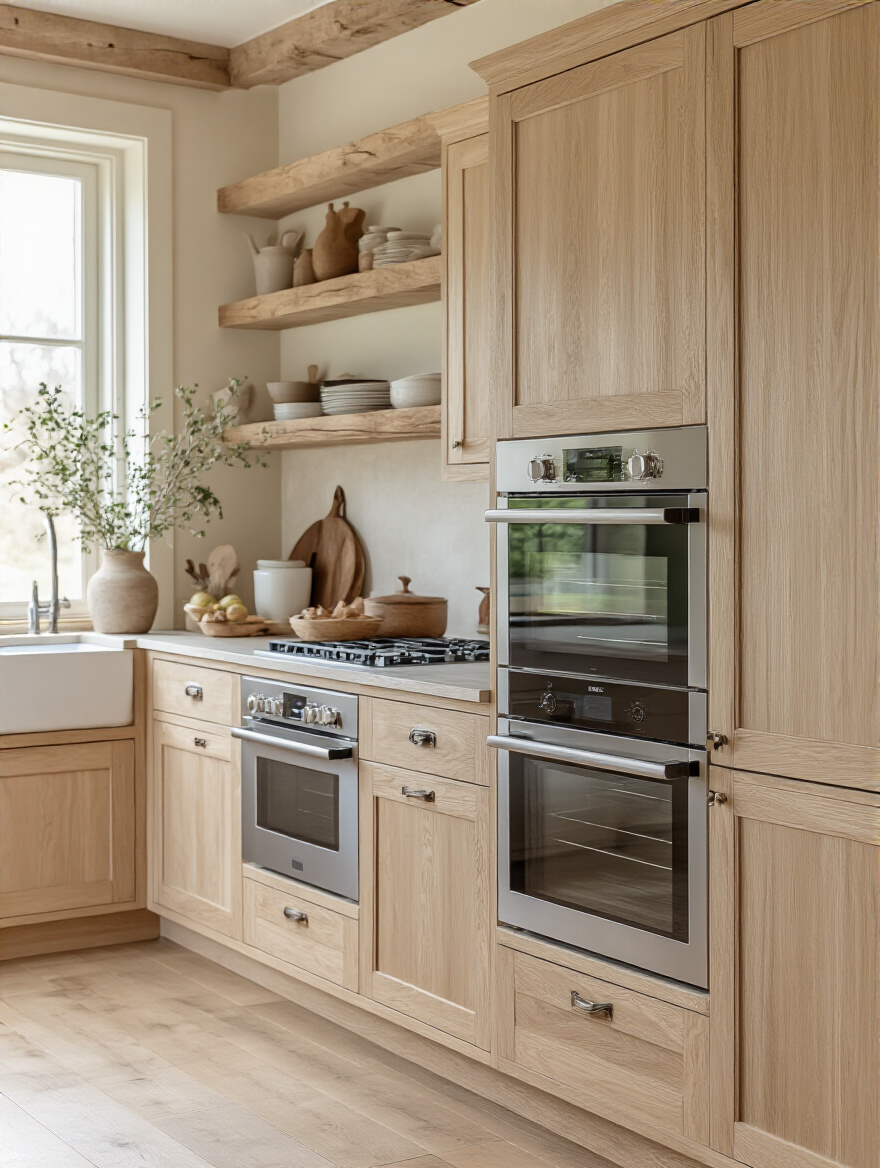
Yes, it’s an investment. But it’s the one thing that separates a nice kitchen from a truly custom, high-end design. When your dishwasher and refrigerator are hidden behind panels that match the rest of your cabinets, the entire room feels more cohesive, serene, and timeless. I always tell clients: if you can swing it, panel the fridge. It makes the biggest visual impact.
After hiding the cold, let’s build in some warmth and comfort.
20. Design a Cozy Built-In Banquette for Informal Seating
There is almost no seating arrangement more charming or space-efficient than a built-in banquette, especially in a corner or a bay window. It creates an instant, cozy breakfast nook that just begs you to sit and linger over a cup of coffee. You can fit more people on a banquette than you can with individual chairs, and it brilliantly utilizes what might otherwise be awkward, wasted space.
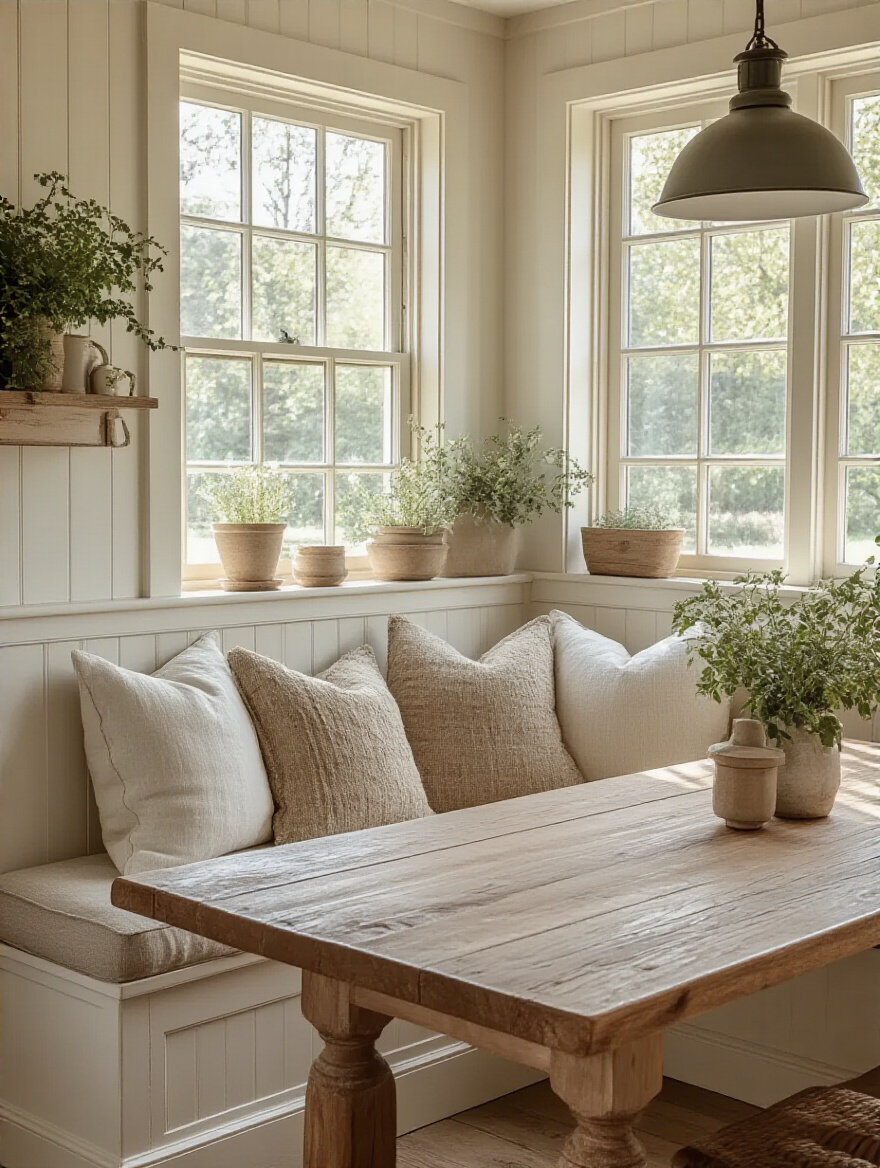
The best part? The storage. The bench can be built with lift-up tops or pull-out drawers underneath, providing a massive amount of hidden storage for things you don’t use every day, like seasonal table linens or kids’ craft supplies. Throw a few soft pillows on it, and it will instantly become the most coveted seat in the house.
From large built-ins, let’s zoom in on the small, collected details that tell a story.
21. Feature a Collection of Unique Ceramic or Earthenware Pieces
A home isn’t built in a day, and a great farmhouse kitchen should feel like it was collected over time. Displaying a collection of unique, handmade ceramics is a perfect way to add that layer of soul. I’m talking about old stoneware crocks, hand-thrown pottery bowls, or vintage transferware plates. These are the pieces that have texture, character, and the subtle imperfections that come from being made by a human hand.
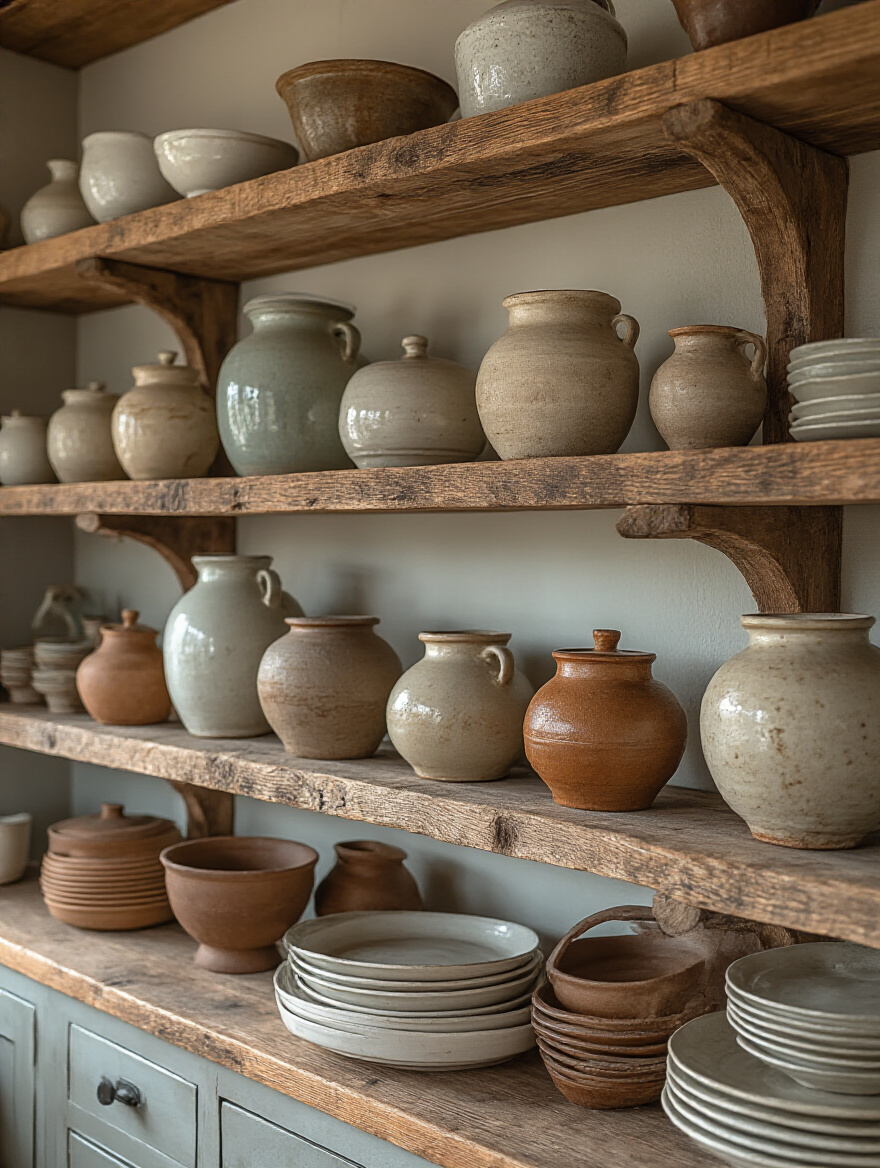
Group them together on open shelves or in a glass-front hutch. Don’t worry if they don’t match perfectly. In fact, it’s better if they don’t. The subtle variations in color and glaze are what make the collection interesting. It’s like displaying art, but art that you can also use to serve a salad. These pieces are the ‘jewelry’ of the kitchen.
Finally, let’s add one last layer of softness and comfort underfoot.
22. Add a Vintage-Style Runner Rug for Color and Comfort
The final touch for any farmhouse kitchen is a runner rug. It adds a welcome pop of color and pattern, breaking up the expanse of wood flooring and defining the main workspace, usually in front of the sink and stove. But its most important job is comfort. Standing on a hard floor for a long time is tiring, and that bit of cushioning makes a huge difference.

Look for a vintage or vintage-style runner. A slightly faded, worn-in pattern looks far more authentic than something brand new and vibrant. It should look like a piece you found at a flea market that just happened to be the perfect fit. And don’t skimp on a good rug pad—it not only stops the rug from slipping but adds an extra layer of glorious cushioning for your feet. For a kitchen, you can even find machine-washable options now that have that great vintage look.
Conclusion
So, there you have it. Creating a farmhouse kitchen isn’t about following a rigid set of rules or buying a “starter kit.” It’s about an ethos. It’s about choosing materials that are honest and durable, a layout that’s functional and welcoming, and details that tell a story—your story.
It’s an investment in a space that serves as the true heart of your home, a bridge between your indoor life and the natural world outside. It’s a room that invites people to gather, to cook, to talk, and to make memories. So start collecting ideas, trust your gut, and build a kitchen that doesn’t just look beautiful, but truly feels like home.
